Elandipole System Gazetteer
Created by Captain Michael Turlogh Kane on Aug 16, 2016 @ 11:58pm
ELANDIPOLE SYSTEM DATASCOPE
CONTENTS
1. The Elandipole Star
2. Elandipole I
3. Elandipole II
4. Elandipole III
5. Elandipole IV
6. Elandipole V
7. Elandipole VI
8. Elandipole VII
***************************************
1. THE ELANDIPOLE STAR
The sun in the Elandipole system is a class G yellow dwarf star. It is slightly bigger than Sol (Earth's sun), with a solar mass of 1.1, but it still accounts for around 99% of all the mass in the Elandipole system. It is the only star in the system, having been formed about 5 billion years ago following the gravitational collapse of matter within a large molecular cloud. Most of this matter gathered in the centre of the collapse, while the rest flattened into an orbiting disc that eventually became the seven worlds in the system. The central mass of matter became increasingly hot and dense, eventually initiating nuclear fusion at its core.
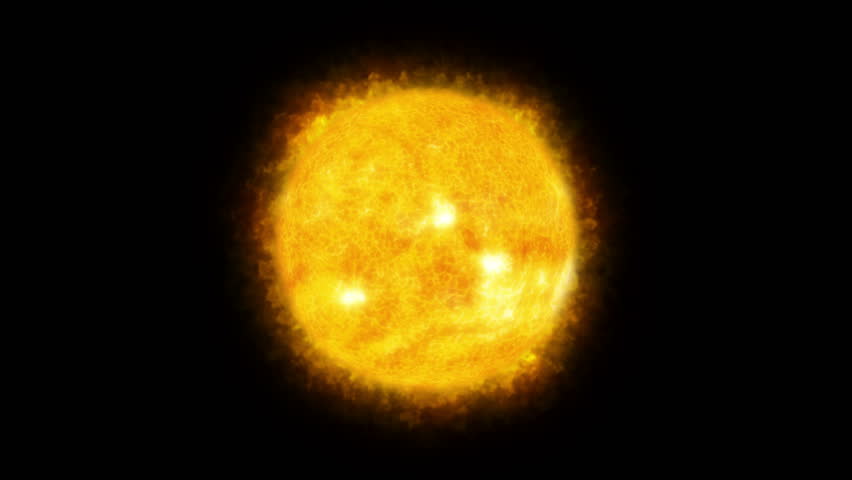
The Elandipole sun has not changed much in the last four billion years, and it will remain stable for at least four billion more. It is composed primarily of the chemical elements Hydrogen and Helium, the former accounting for almost three-quarters of its mass, and the surface temperature is estimated to be around 10,000 degrees Fahrenheit. It is surrounded by a standard magnetic field that extends into the star system.
*****************************************************
2. ELANDIPOLE I (E-1)
The innermost planet in the Elandipole system, E-1 is a barren rock hurtling around its parent star at high speed, completing an orbit in only 58 days. It has no known natural satellites, as it has almost no gravity of its own. Lacking an atmosphere to retain heat, E-I's surface is a scorched hellhole that experiences the greatest temperature variations in the Elandipole system, ranging from -280 degrees Fahrenheit during its night-cycle, to the blistering daytime temperatures exceeding 500 degrees Fahrenheit at its equator. It is a tiny world, only barely qualifying as a planet.

Scans of E-1 indicate that it has been geologically inactive for millions of years. It is possible that the planet was once much bigger, but that its mass has been drastically reduced over time by vapourisation from the Elandipole sun's heat. Its core is molten rock, made up of various silicates. There is nothing further of note regarding this ball of rock in space.
*********************************************************
3. ELANDIPOLE II (E-2)
E-2 is quite close to E-1, separated from it by only 110 million kilometres, so much so that both planets are plainly visible from each other by the naked eye. Like its smaller sibling, E-2 is a barren, scorched lump of rock. It orbits at a slightly slower pace (72 days), and has no atmosphere to speak of. It is slightly larger than E-1, but not noticeably so. However, it does have one interesting feature.
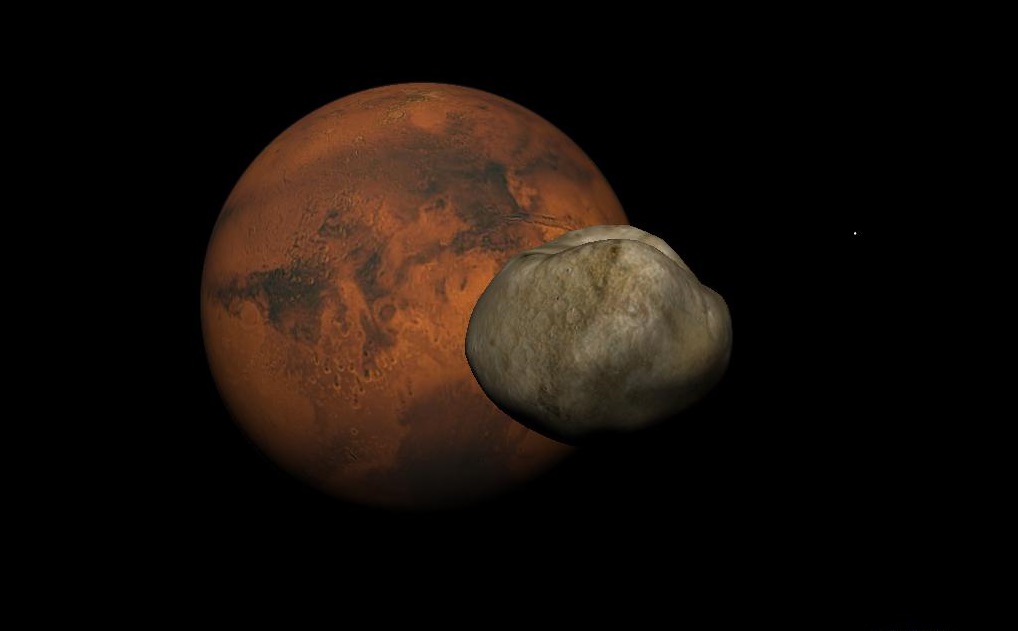
E-2 with its asteroid moon
An enormous lump of rock orbits E-II, probably a large asteroid that took up the circle many millions of years ago. But thanks to a fortuitous turn of events, the large asteroid is caught almost perfectly between the gravity well of E-II and its parent sun. It is completely tidal locked in its orbit, remaining overhead and casting its shadow on the same point on E-II's surface, giving the bizarre sight of a huge lump of rock that would be permanently visible from the barren, scorched surface.
*******************************************************
4. ELANDIPOLE III (E-3)
The third planet in the Elandipole system is like the first two - rocky and barren. However, E-3's surface is craggy and pitted with craters, ranging from small bowl-shaped cavities to multi-ringed impact basins hundreds of kilometres across. E-3 was probably heavily bombarded by comets and asteroids during its formation around 4.6 billion years ago. With no atmosphere to slow impactors, the surface has been completely shattered. Its orbit is a long, straggling thing that takes over 100 days to complete, and twice on its long journey it enters the system's Goldilocks zone. However, there is no life to speak of on E-3.
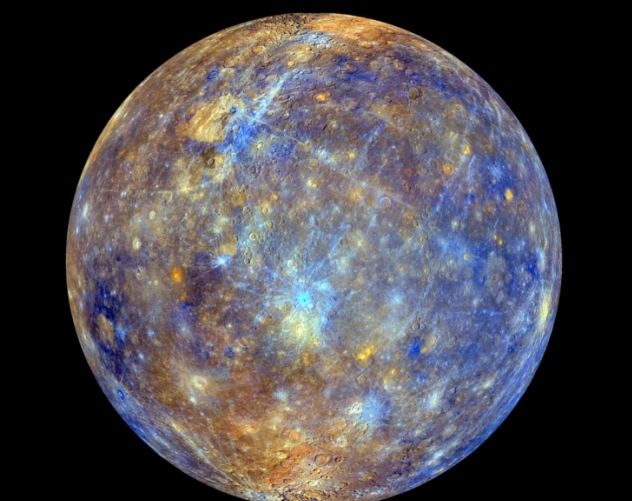
It's metallic blue, not atmosphere blue
E-3 is a mineral treasure-trove, with high deposits of iron, titanium, vanadium, cobalt, nickel, and tungsten. If the Elandipole system is ever colonised by the Federation, it is recommended that automated mining stations be constructed on this world at the earliest opportunity.
**********************************************************
5. ELANDIPOLE IV (E-4)
Position in System: 4
Number of Satellites: 0
Planetary Gravity: 0.8G
% Land Mass: 6%
Planetary Diameter: 10,400 km (6,400 miles)
Plentary Rotation: 23 hours
Atmospheric Density: Terrestrial
General Climate: Warm Temperate
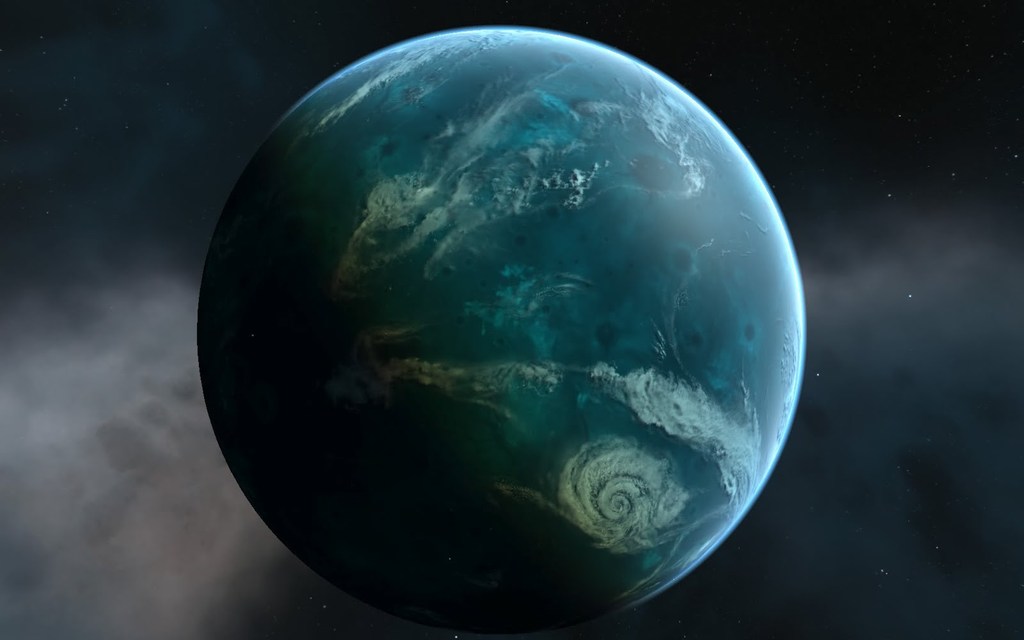
Bring your swimming trunks, it's a bit wet
The only class M world in the Elandipole system, with an atmosphere almost identical to Earth, E-4 is a tide-locked waterworld slightly smaller than Earth. It is a scientific misconception that a world without a natural satellite has no tides - in fact, like any world with water on its surface, E-4 is affected by the gravitational forces of its sun, and thus has tides. They vary in size and strength across the planet, and are of much lesser force and size than those of Earth, but are noticeably present, especially if one spends time on any of the atolls and tiny islands that are scattered across the planet's surface. Less than one-tenth of the planet is land, but the stability of its orbit, the warm temperature nature of its climate, and the gentleness of its tides makes for something of a beach lover's paradise. The atolls and small islands are blessed with spectacular unspoiled beach settings, and the golden sunrises and sunsets are especially beautiful.
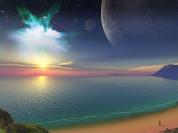
If you had a girlfriend, you could take her here for a romantic walk
What land there is is crammed with plant life, mainly sub-tropical trees and bushes that compete for the best growing space. In turn, this has allowed some alien life to evolve on E-4.
The brightwing is a species of avian native to E-4. It is about the size of the Earth seagull, and just as raucous. It is a spectacular aviator, able to soar for hours on the warm wind currents either alone or in flocks. When it dives into the water to seize a passing fish, it assumes an arrow-like posture, stabilised by its resplendent tail feathers, and divebombs its prey from above.
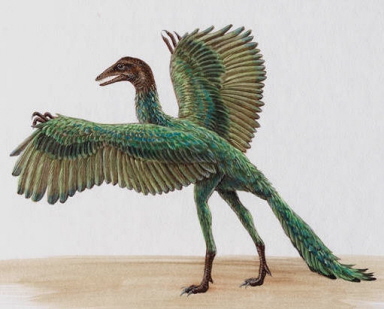
The brightwing will probably take your finger off
Most of E-4's life is in the world-ocean, and it is teeming with life. There are many hundreds of alien species of fish, but none of them are sentient. It is for this reason that the Federation has earmarked E-4 as a future colonisation site.
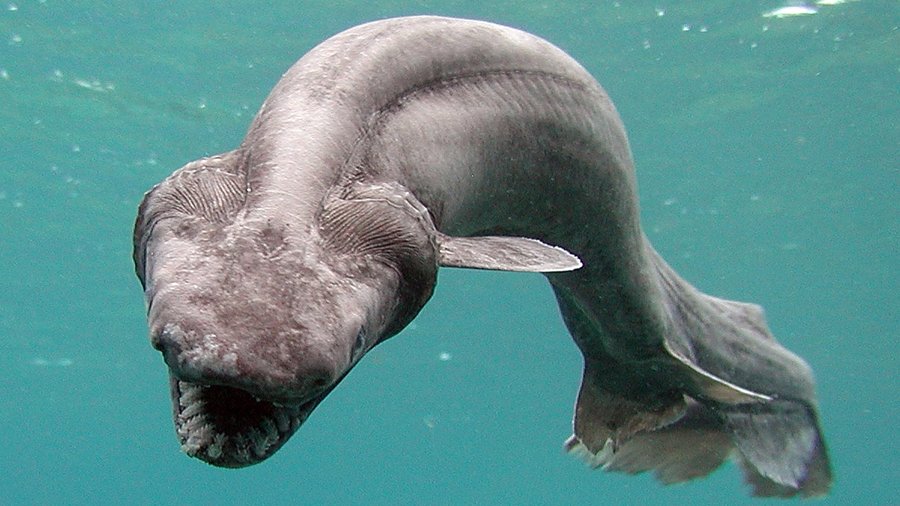
The Elandipole frilled shark just wants to play
The frilled shark (above) is one of the more dangerous creatures inhabiting Elandipole's world-ocean. It has a five metre-long dark brown, eel-like body, with dorsal, pelvic and anal fins placed far back on its body. It lunges through the water by bending its body like a snake, seizing its prey in long, flexible jaws lined with rows of needle-like teeth. It feeds mainly on cephalopods, and tends to inhabit deeper water, but can occasionally be seen close to any of Elandipole's land masses. Interestingly, this species is viviparious - the female stores the fertilised eggs inside her body until they hatch. Young frilled sharks live inside their mother's body, surviving on their egg yolks, until their backbones are strong enough to swim, at which point the mother goes into labour and 'births' them in shallow water.
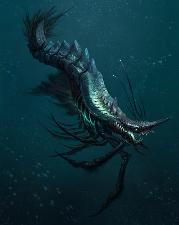
The Elandipole caridea is coming for you in your dreams
In the deepest, coldest waters of Elandipole's world-ocean, lives a ferocious predator called a caridea (above). Generally inhabiting depths below 10,000 feet, these whale-sized monsters have been scanned by underwater sensors, but never seen in the flesh. They are giant decapod crustaceans, with a long, muscular tail, long whiskers, and slender, sharp legs to scuttle along the ocean floor. Its abdomen is large and long, making it well adapted for swimming, and its chitinous exoskeleton is thick and heavy to withstand the water pressure of the depths it lives at. They are believed to be the apex predators of Elandipole's oceans, eating anything they come across.
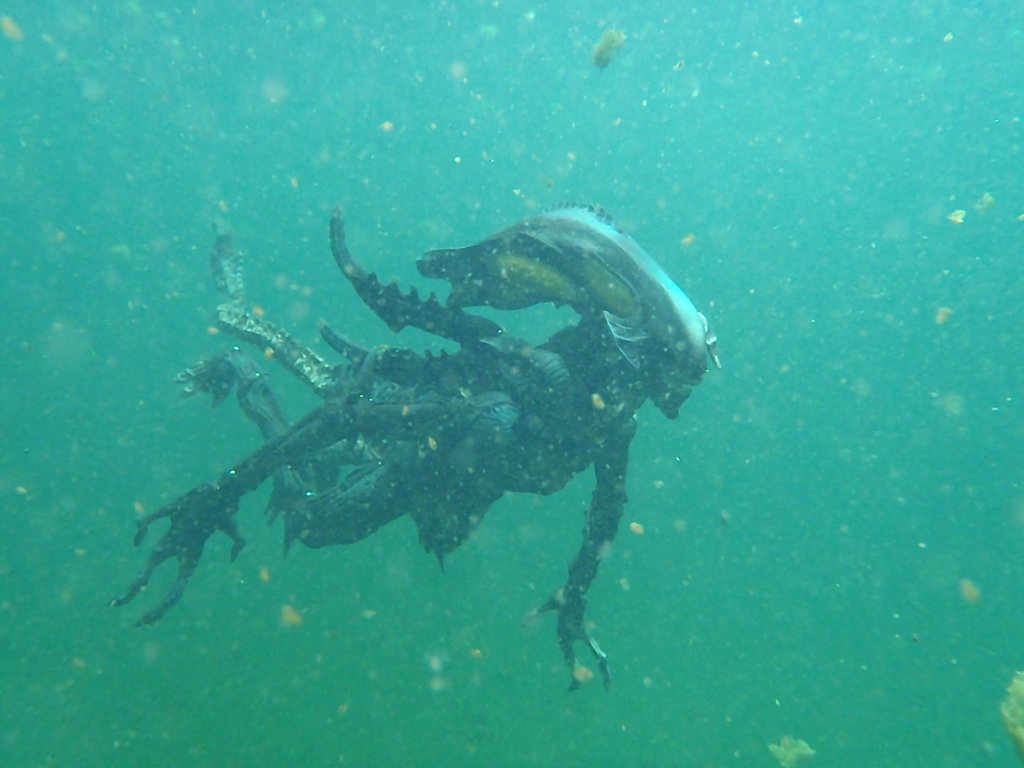
The Elandipole kampos wonders what you taste like
Despite its dangerous appearance, the Elandipole kampos (above) is quite non-threatening, and a common sight in shallow waters. They appear to be some kind of cross between a fish and a crustacean, with both scales and a bony exoskeleton on their body. They move through the water with the aid of large flippers on their rear limbs. The large frill on the top of the cranium seems to flush various colours at different times - it is assumed that the kampos uses the colours to communicate, but nothing else is known. They seem to live in large, extended families within territories, and it is not uncommon to see groups of kampos fighting each other in the shallows when one family's territory is invaded by another. How they reproduce is unknown, as it is difficult to tell the gender of one particular kampos through observation alone. They feed on small shallow-water fish, but can occasionally be seen scouring the sea-floor for a crustacean or two. They seem quite interested in divers, often stopping what they are doing and simply watching from a safe distance.
***********************************************************
6. ELANDIPOLE V (E-5)
Far out in the Elandipole system lie three gas worlds. There is a sizeable gap in distance between E-4 and the outer three worlds - some 600 million kilometres lies between the fourth and fifth worlds.
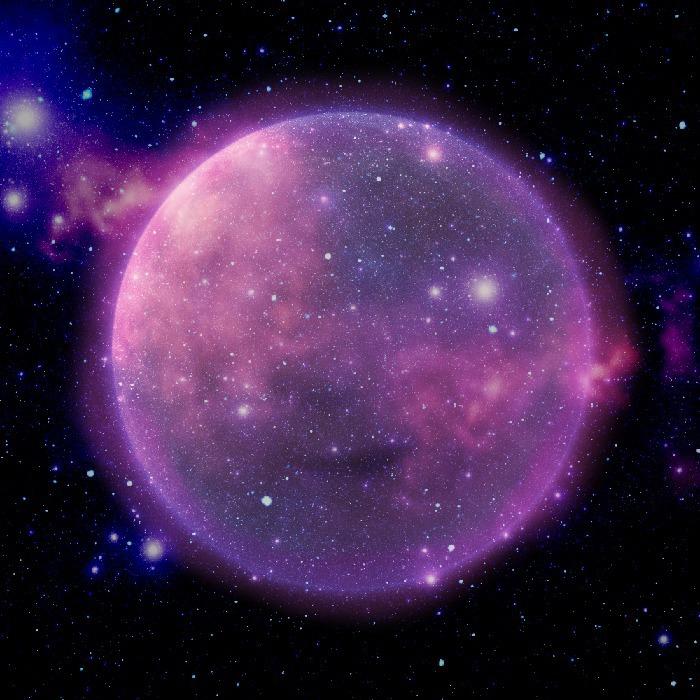
E-5, the Rainbow Planet
The fifth planet in the Elandipole system is referred to as The Rainbow Planet (above) by Federation astronomers. Composed mainly of hydrogen and helium, there is a veritable smorgasboard of other trace gases in its makeup. This gives rise to a stunning colour palette of clouds that are primarily made up of water molecules - as the light from the distant sun shines through the water molecules, the light is split into colours of every shade as it alternately heats up or cools down these trace gases, giving the planet many different hues. It has no moons.
*****************************************************************
7. ELANDIPOLE VI (E-6)
The second of the three outlying gas worlds in the Elandipole system, E-6 is a large gas giant about 100 times the size of Earth. Its interior core is probably composed of iron, nickel and rock, and it has a pale orange-yellow hue due to the presence of ammonia crystals in its upper atmosphere. It is composed of around 95% hydrogen, with methane and ammonia making up most of the rest.
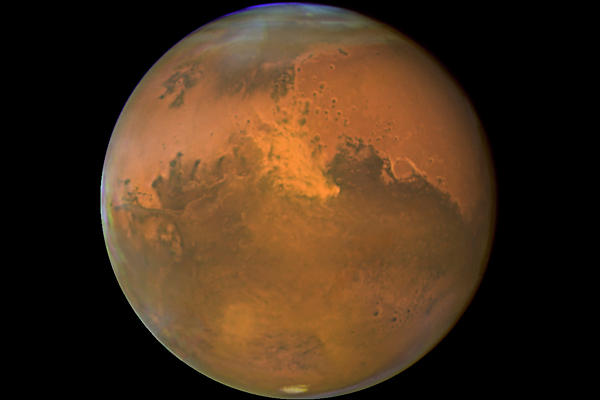
E-6, planet of storms
One of the more striking features of E-6 is its storms. Wind speeds on E-6 can reach as high as 1,800 kilometres per hour, or 500 metres per second, giving the atmosphere a smooth, whipped consistency like butterscotch.
******************************************************************
8. ELANDIPOLE VII (E-7)
The farthest planet from its sun, E-7 is a cold, distant gas planet. It is composed mainly of oxygen, carbon, nitrogen, and sulphur. It is a special type of planet called an ice giant, because during its formation E-7 incorporated its material as either ices or as gases trapped in water. Today, there is no ice on E-7.
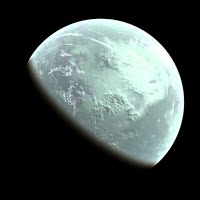
E-7, cold and distant like your parents
E-7 is characterised by high equatorial winds, polar vortices and large-scale wind circulation patterns, making it a good candidate for the study of atmospheric physics.
************************************************************** **************************************************************
Categories: E
